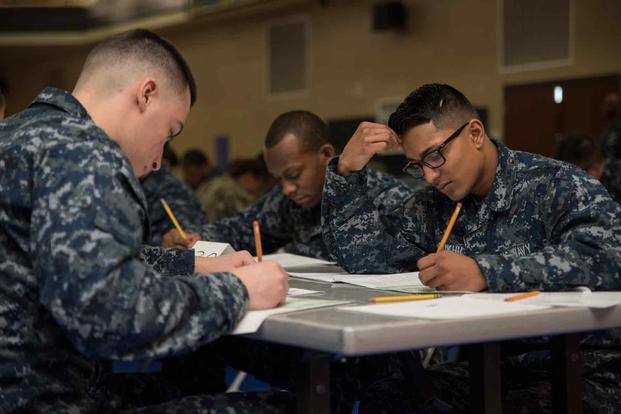The Navy announced that it is making promotion to E-4 -- the most junior petty officer and noncommissioned officer in its ranks -- automatic.
In an administrative message released Thursday, the service announced that, starting in July 2024, sailors at the rank of seaman, or E-3, will automatically be promoted to petty officer third class, or E-4, after having served 30 months in the Navy.
This is a major shift from the prior method. Sailors had to serve a minimum amount of time at the rank of E-3, take an advancement exam offered twice a year, and have their scores added to a complex formula that would compare them against all other sailors going for E-4 in their specific specialty to determine who would make the cut based on quotas set by the Navy.
The new policy also sets the time sailors need to serve for automatic advancement to E-2 at nine months of service, and 18 months for E-3.
Fleet Master Chief Delbert Terrell, the top enlisted sailor at the office of the Chief of Naval Personnel, told reporters Thursday that the change is part of the Navy's move to billet-based advancement.
The new process aims to tie two factors of a sailor's career -- promotion and new orders -- together. Navy officials have previously said that the goal behind the overhaul is to benefit the service by getting higher-ranking sailors into matching jobs more quickly, as well as giving them more control and transparency over their careers.
Terrell said that the expansion of the program, which began with its highest enlisted rank -- master chief petty officers -- "creates more opportunities for more sailors" to take advantage of a more predictable advancement schedule.
Once sailors become third-class petty officers, they will have the opportunity of promotion to petty officer second class, or E-5, either through the traditional advancement exam or the new marketplace for billet-based advancement orders that offer the promotion as part of the set.
Terrell said that, as more sailors enter this new marketplace of orders and promotions, "there's more opportunities [for sailors] to go not only where the Navy needs them to go at that paygrade in that rate, but also in discussion with their family."
However, there's also a benefit for the Navy of being able to incentivize sailors to take hard-to-fill jobs -- like those on ships -- and close a long-standing gap between how many sailors it has in sea-based jobs and how many it needs.
"Overall, it will not only take care of the sailor and their family but the Navy … reducing those gaps and getting that right sailor there," Terrell said.
As the policy rolled out, some sailors remarked in social media posts that making the promotion will disincentivize top performers or allow underperforming sailors to advance despite their lack of work ethic or job skills.
A fact sheet on the policy notes that commanding officers will still have the ability "to advance their top-performing sailors with necessary E-3 experience to E-4 early." Meanwhile, on the other end of the spectrum, sailors will not be able to advance if they lose their retention recommendation in their annual performance evaluations either through poor performance or disciplinary actions.
The new policy also notably excludes some sailors.
The message noted that sailors in nuclear, advanced technical and electronics fields "who already obligate for additional service in order to advance to E-4" will "continue to receive an accelerated advancement for service in those needed skill sets."
Meanwhile, those without a job specialty -- commonly referred to as undesignated sailors -- will continue to choose their specialties and move up to E-4 in line with the requirements of the Professional Apprenticeship Career Track -- or PACT -- program. The Navy's message noted that this timeline is similar to the one for the rest of the fleet.
Ultimately, Terrell hopes that the new advancement plan will help sailors stay in the Navy by offering a more predictable career.
"Sailors coming in -- at 30 months -- they now have that plan to continue and follow in a career, which is ultimately going to help with retention," he told reporters.
-- Konstantin Toropin can be reached at konstantin.toropin@military.com. Follow him on Twitter @ktoropin.
Related: The Navy Begins Major Revamp of Promotions, Starting with Master Chiefs













